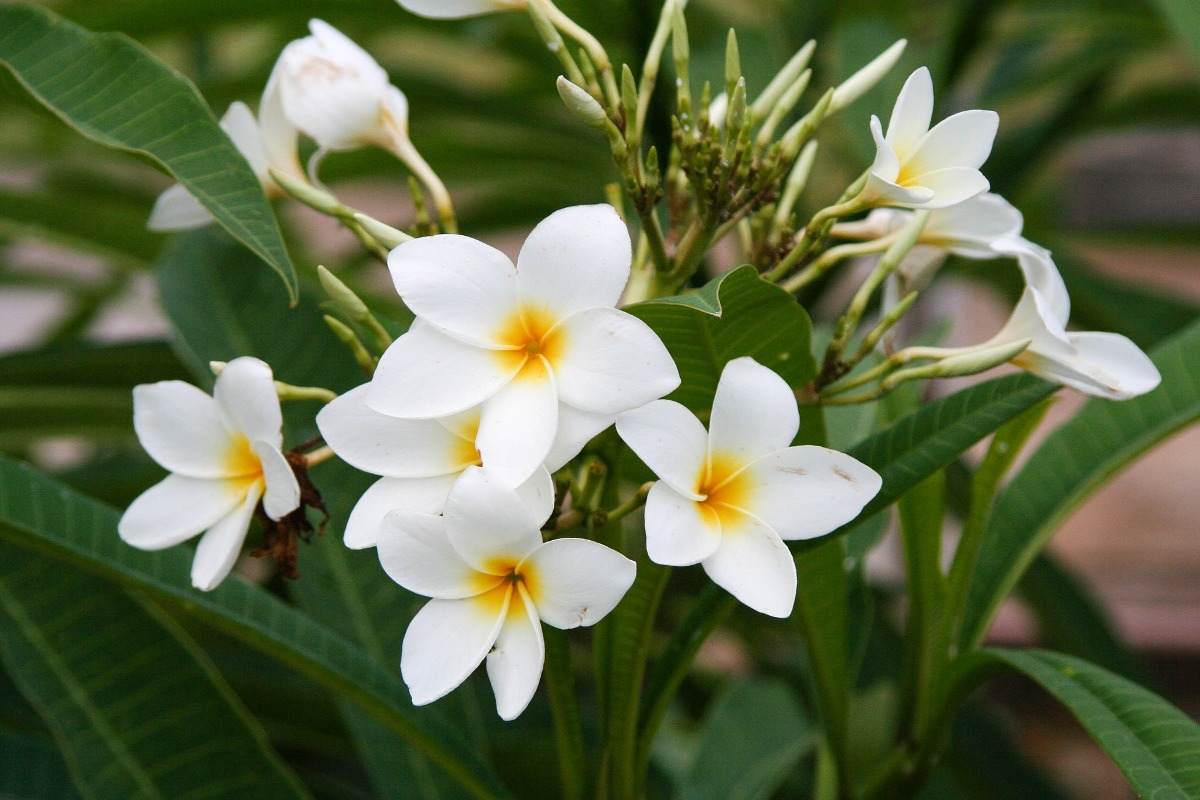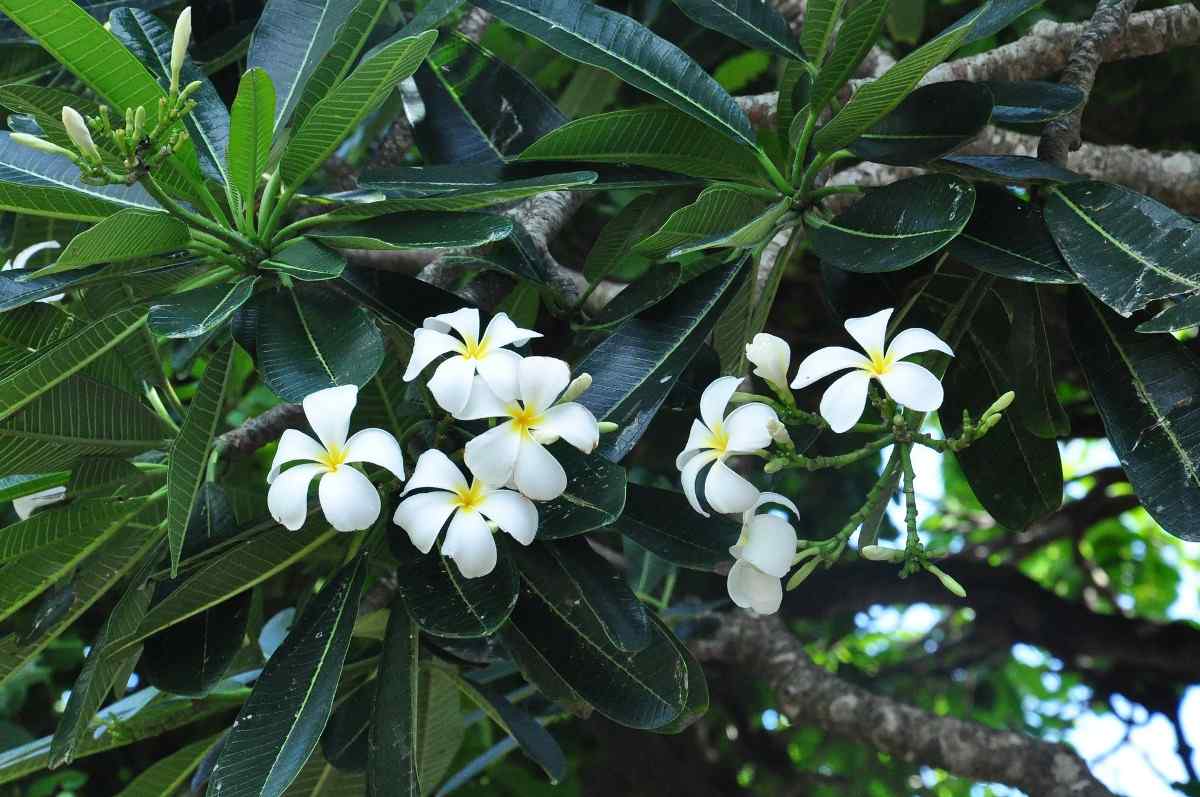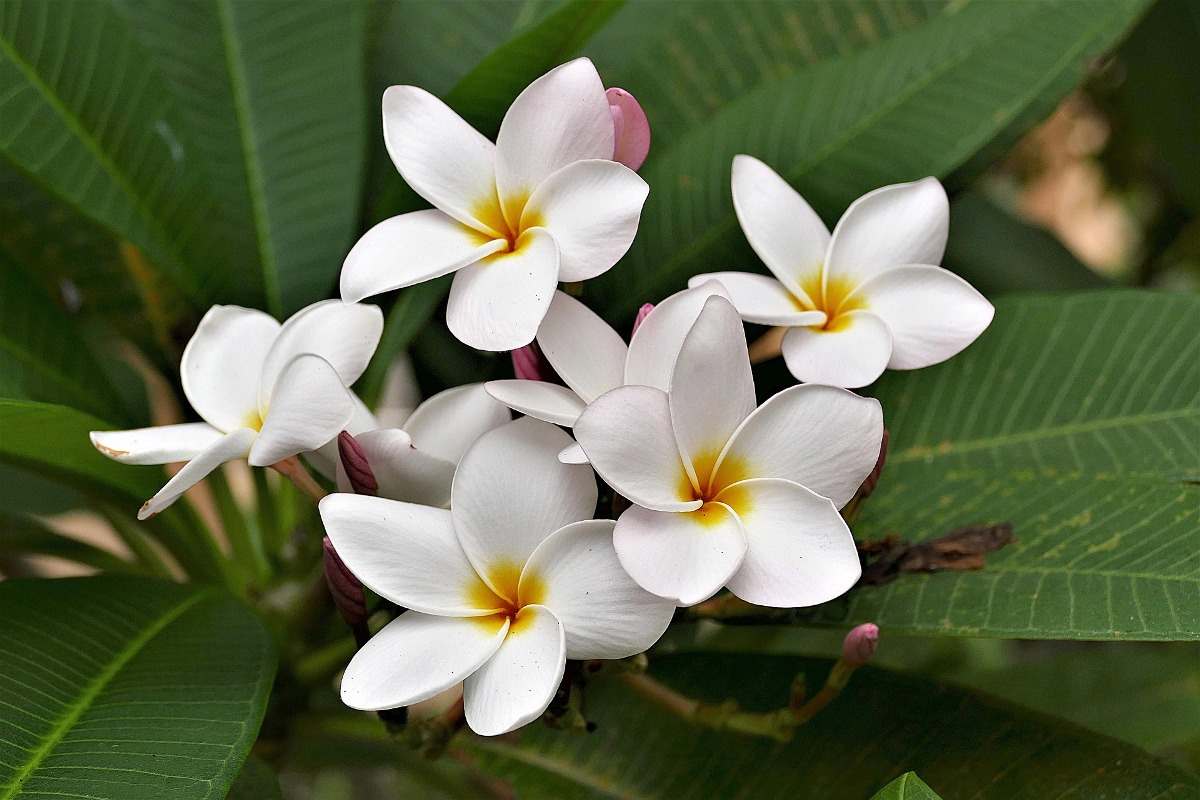Growing Plumeria (Champa) at Home
Plumeria is a genus of flowering plants in the Apocynaceae family. Plumeria is also called Champa or Frangipani. These plants need to be grown in well-draining soil that is slightly acidic. They also need at least 6 hours of full sun. While the Plumeria plants are fairly tolerant of both salt and windy conditions, they’re not tolerant of cold and must be protected. So, they should be container grown in colder regions. By choosing the right location for growing Plumeria, ensuring that the plant is not overwatered, and caring for it seasonally, your Plumeria will grow strong and beautiful.
A step by step guide to growing Plumeria (Champa/Frangipani)
Plumeria plants grow well in greenhouses or near a big window with lots of light if you are growing it inside.
- Growing Plumeria in pots indoors
- Plumeria plant care
- Why is my Frangipani not flowering
- Growing Plumeria from cuttings
- How can I make my Frangipani grow faster
- Frangipani growing conditions
- How to propagate Plumeria plant
- What is the best fertilizer for Frangipani
- Frangipani growing from seed
- Can Frangipani be grown in pots
What soil is best for Plumeria plants?
When growing Plumeria plants in pots use well-draining potting mix, cactus mix or perlite and sand should be fine. To check the soil, stick your finger about an inch into the garden soil and if it’s wet, don’t water it. You can use a soil moisture gauge to help keep the right level of moisture. You might also want to grow Plumeria in a terracotta pot, which will help the soil dry out faster.
Pot/Container size for growing Plumeria plants
Choosing the correct container for Plumeria plants may be one of the most important factors in determining how well it will perform for you. Experience has shown that Plumeria plants need ample root room while actively growing. The plants are grown in the open ground always perform and bloom better than those held captive in small pots. A general rule of thumb is to allow 1-gallon pot size for each foot of the Plumeria branch or trunk length. By choosing a large enough pot, you allow more room for root growth which in turn leads to better moisture and nutrient uptake by the Plumeria plant.
Sunlight requirement for growing Frangipani
In case if you miss this: Hydroponic Farming in the Balcony.

As with most of the flowering plants, Frangipani trees require plenty of sunlight for proper flowering. If growing the Frangipani plant in pots, it does best with afternoon shade; otherwise, full sun or at least 6 hours of sunlight is preferred.
Obtain seeds or cuttings of Plumeria plants
First, you will need to plant Plumeria seeds or cuttings to grow your own Plumeria. Unfortunately, these are not very commercially obtainable. It can be a challenge to find them, so your best bet is to get them from someone who already has a Plumeria. Perhaps a neighbor or relative already has a Plumeria and can be willing to share these with you. The seeds and cuttings can be harvested in the spring or fall to allow for the propagation of the Plumeria plant. Seeds and cuttings can also be found online, although there are some concerns about the quality of these since Plumeria seeds and cuttings lose viability within a few months.
Seed selection for growing Plumeria
Seed selection is important when growing Plumeria seeds. Plumeria seeds do not produce true to their parents. And, sometimes a seedling will look like its parent, but it will never be exactly the same. A few characteristics to consider;
Flower – Color, size, keeping quality (how long it lasts after picking), and fragrance, etc.
Tree – Growing habit, size, etc.
Leaves – Color, size, etc.
Blooming – Quality, size of inflorescence/flower stalk, number of flowers blooming at the same time, and how long it blooms, etc.
Germinate the Plumeria seeds
This involves placing the Plumeria seeds in a wet paper towel for one full day. They will absorb the moisture and look slightly swollen, indicating they are ready to grow. This will help them to take root more quickly and make sure they are in a warm environment while germinating.
How to start a Plumeria cutting
- Select a healthy mother plant for cuttings
- Allow the milky sap from the cutting to dry
- For best results use 12 inches cuttings at a minimum
- Prepare the soil of 2/3 perlite and 1/3 peat
- Fill the pot with the potting mix leaving 1 to 2 inch from the pot rim
- Dip the bare root cutting into a rooting hormone powder (some recommend allowing the cutting to dry for a week before planting)
- Stick the cutting into the pot
- Firmly press the soil around the cutting and add more soil if needed
- Water until water runs out of the drain holes
- Place the pot in a warm and sunny location
- Roots should develop in 3 to 5 weeks
Steps for propagating Plumeria cuttings
- After taking the Plumeria branch cutting, remove the largest plant leaves from the cutting
- Then, allow the cut end to callus over for a few days before trying to root it or it may rot
- Dip Plumeria cutting into rooting hormone, then stick it into a propagation soil made with perlite, soil, and sand, and use a gritty succulent soil mix
- Mist the cutting regularly, and put it in a humid environment but don’t water it
- Once you see new growth on Plumeria cutting, that’s a sign that it has grown roots
- Now you can water it, and fertilize it; treat it like you would the parent plant
Plant a Plumeria in pots
Step 1) Cut a healthy limb tip in the spring that is about 12 or more inches long of new growth with pruning shears. Plant the Plumeria in a 10-inch deep and wide container with 1 part topsoil and 1 part sand. After 2 years, the plant will need to be repotted in a 12 to 14-inch deep and wide container.
Step 2) Water the Plumeria plant when the soil is dry. Stick your finger in the soil 1 inch. If the soil is damp, don’t water. When the soil feels dry, add water to soak the Plumeria plant.
Step 3) Place the container in a sunny window where the Plumeria plant will receive full sun with some shade during the day. If sunny windows are not available, then grow the Plumeria under a fluorescent light, but keep the light on for 15 hours a day.
Step 4) Keep temperatures indoors 26 to 32°C. If that temperature is too high for indoor living, the Plumeria will do just fine with daytime temperatures of 23°C and night temperatures of 15 to 21°C.
Step 5) Fertilize the Plumeria plant with 10-50-10 (nitrogen-phosphate-potassium) water-soluble fertilizer every other week to promote flowering.
Step 6) Control the height of the Plumeria plant indoors by pruning the branches. Use a sharp knife and make an angle cut to remove top sections of branches to keep the plant height manageable. Then, new branches will start growing at the point where branches are pruned.
How to grow Plumeria from seed pods
- Acquire seed pods or seeds from your local garden store or online
- Fill small plastic trays or pots will rich and well-drained potting mix
- Place the Plumeria seeds in the soil leaving the wings sticking up
- Firm soil around seeds to ensure good contact
- Keep the soil moist and place in a sunny location
- Seed germination takes about 21 days
Watering the Plumeria tree
When watering Plumeria trees, remember they do not like wet feet. Water frequently when the plant holds lots of foliage and flowers, usually from March to late November. Only water the plant when the soil becomes dry. When summer rains arrive, and actively growing, you do not want to think about watering. When the Plumeria plant leaves start to fall, stop watering. Watering plants while in dormancy leads to killing the plant.
Reasons for a Frangipani not blooming
There are mainly three reasons for a Frangipani not blooming. In addition to the 6 hours of bright light the Plumeria plants require, they also need fertilizer at the right time and pruning occasionally. Pests can attribute to non-blooming in plants. If the fertilizer is not the right type and is not applied at the right time, it can affect Plumeria blooming. Fertilize Plumeria plants during the spring and summer. Another reason a Frangipani plant will not flower is that the stems are not old enough. Young plants, or those that have been pruned, need at least 2 years before the wood is ready to make buds and flowers. Insects such as thrips, aphids, and mealybugs will threaten overall vigor but can cause withering and dropping off new buds, another possible cause when a Plumeria does not bloom.
How to prune Plumeria plants
You should not miss this: Growing Ash Gourds Indoors.

Plumeria plants will grow tall and leggy over time, so it’s best to prune them regularly to keep them looking their best and also to encourage tons of flowers. Pruning your potted Plumeria plants helps to keep it small, and maintain a compact, fuller shape. Plumeria plants can handle a pretty severe pruning but never cut them all the way down to the ground. Also, keep in mind that heavy Plumeria pruning will probably keep plants from blooming for a while, so don’t recommend it unless it’s totally necessary. It’s best to prune Plumeria plants in the spring or right after they are done blooming.
Pruning Plumeria plants encourages the plant to put on new growth, and you don’t want that in the fall or winter months. Use sharp (and sterile) pruning shears to prune Plumeria, so you make sure to get a nice clean cut. You can wash pruners with soap and water, or dip them into rubbing alcohol to sterilize them. Also, Plumeria plants are very sensitive to tip rot, so make sure to make your cuts at an angle where water can’t settle into the cut and cause the branch to rot. Don’t forget to keep your Plumeria cuttings and propagate them for new plants.
Plumeria plant care
The best fertilizer for Plumeria plants is one that is high in phosphorous, such as 10-30-10. The granular formula is preferable to liquid.
Few problematic diseases and pests attack Plumeria plants. Plumeria rust, an Orange powder, or blisters may cover the foliage or on the undersides of plant leaves. The rust can cause defoliation but the loss of leaves is rarely life-threatening to the Plumeria plant. Treat the problem with a fungicide.
Pests such as spider mites, black and yellow aphids, mealybug insect, whiteflies, and Plumeria scale insects may attack. Control the insect problem or kill black aphids with spray applications of insecticidal soaps. Plumeria stem borers can damage the plant stems from the inside out causing the plant to wilt or die. Remove the infected branches and leaves.
Commonly asked questions about growing Plumeria
You may be interested in this: Growing Vegetables in Shade.

Can Plumeria be grown indoors?
Because shrubs are adaptable to many conditions, the Plumeria plant can be grown in containers indoors as houseplants.
How do I make my Plumeria smaller?
Pruning your potted Plumeria plant helps to keep it small, and maintain a compact, fuller shape. Plumeria plants can handle a pretty severe pruning but never cut them all the way down to the ground.
How do you care for an indoor Plumeria plant?
When watering potted Plumeria plants, water them deeply. However, be sure to let Plumeria dry out between watering because the Plumeria plants do not like wet feet. Your Plumeria will appreciate a little humidity courtesy of morning and bedtime mist on its leaves.
How do I make my Plumeria grow faster?
Low lighting and unusually long cool seasons are the two factors preventing normal growth for Plumeria plants. While plants tolerate light shade, they photosynthesize and grow fastest (not to mention put on more fragrant blooms) when exposed to full sunlight. Plumeria plants choose dry soil and warm air.
Why is my Plumeria turning black?
The fungus called a black tip occurs after the Plumeria crowns have been exposed to frost or sometimes just cold winter morning dew. The healthier the Frangipani, the more resistant it will be to blacktip damage. Some fungicides treat it better than others but it can be treated.
Why are the leaves on my Plumeria curling?
Some Plumeria plants lose their leaves when the weather turns cool, distorted growth, leaf curl and yellowing are signs of an infestation of sap-sucking insects like mealy bugs, spider mites or thrips. Water them thoroughly to help reduce stress on the Plumeria, which can lead to a weakened resistance to pests.
Why are my Plumeria flowers turning brown?
Plumeria plants can rot from getting too much water and standing in wet soil. Sometimes Plumeria bud drop is caused by cold temperatures and overnight temperatures can dip at the end of the growing season
Why does Plumeria lose their leaves?
Most Plumeria plants will lose their leaves during winter dormancy. This procedure eliminates the plant’s need for water. Remember, no leaves, no water. This stops new tender growth from forming very late in the season, would be more susceptible to damage in the winter.
How long does it take to grow Plumeria from seed?
Depending on the freshness of the seeds, it will take from 7 days to over a month for them to germinate.
Can you plant a Frangipani cutting straight into the ground?
Frangipani plants are quite easy to grow from a cutting. Once the base has dried out, plant the cutting in a pot of coarse sand and water for about once a week until plant roots form. Once the cutting has roots, then it can be transplanted into a pot of soil with good drainage or straight into the ground.
In case if you are interested in How to Make Money from Dried Flower Business.